
In Mahayana and Vajrayana Buddhism, the Five Tathāgatas (Skt: पञ्चतथागत, pañcatathāgata; (Ch: 五方佛, Wǔfāngfó) or Five Wisdom Tathāgatas (Ch: 五智如来, Wǔzhì Rúlái), are the five cardinal male and female Buddhas that are inseparable co-equals, although the male cardinal Buddhas are more often represented. Collectively, the male and female Buddhas are known as the Five Buddha Families (pañcabuddhakula). The five are also called the Five Great Buddhas, and the Five Jinas (Skt. for "conqueror" or "victor").
The Five Buddha Families are a common subject of Vajrayana and Tibetan Buddhist mandalas and they feature prominently in various Buddhist Tantras as the intrinsically inseparable father and mother Buddhas. Various sources provide different names for these male and female Buddhas, though the most common names today are: In the east, Vairocana and Buddha Locana; in the south Ratnasambhava and Buddha Mamaki; in the west Amitābha Panadaravasini; in the north Amoghasiddhi and Samayatara; and in the center Akshobhya and Dhatvisvari. They are sometimes seen as emanations and representations of the five qualities of the Adi-Buddha or "first Buddha", which is associated with the Dharmakāya. Some sources also include this "first Buddha" as a sixth Buddha along with the five.
In Japanese Buddhism, the Five Tathagathas are the primary objects of realization and meditation in Shingon Buddhism, a school of Vajrayana Buddhism founded by Kūkai. In Chinese Buddhism, veneration of the five Buddhas has dispersed from Chinese Esoteric Buddhism into other Chinese Buddhist traditions like Chan Buddhism and Tiantai. They are regularly enshrined in many Chinese Buddhist temples, and regularly invoked in rituals such as the Liberation Rite of Water and Land and the Yoga Flaming Mouth ceremony (瑜伽焰口法會), as well as in general prayers and chants.
They are also sometimes called the "Dhyani-buddhas", which is a term first recorded in English by Brian Houghton Hodgson, a British resident in Nepal, in the early 19th century, and is unattested in any surviving traditional primary sources.
History

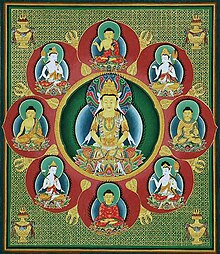

The Five Wisdom Buddha families are a development of the mature Buddhist Tantras. The now standard five Buddhas first appear in the Sarvatathāgatatattvasaṃgraha sutra (Compendium of Principles, c. late 7th century) and Vajrasekhara Sutra.
However, the tradition of various Buddhas corresponding to the main cardinal directions is not new to the Buddhist tantras. The idea appears in Mahayana sutras like the Sutra of Golden Light (c. 5th century) and the Sukhāvatīvyūha Sūtra. The Golden Light for example, has a mandala with Shakyamuni in the center, surrounded by Ratnaketu (south), Amitayus (west), Dundubhisvara (north) and Aksobhya (east) Buddhas. This set already includes three of the main five Buddha family Buddhas found in the tantras.
Furthermore, examples of four Buddhas arranged in the four cardinal directions are found in Indian Buddhist stupas like Sanchi stupa, Udayagiri stupa, Jajpur stupa (Pushpagiri) and Dekhinath stupa (Gyaraspur). The Udayagiri stupa for example, houses Vairocana, Amitabha, Aksobhya and Ratnasambhava in the four cardinal directions of the stupa.
According to Kimiaki Tanaka, this basic four cardinal directions Buddha model, combined with Vairocana Buddha from the Avatamsaka sutra, developed into the later tantric five Buddha families (which changed the other two Buddhas' names to Amoghasiddhi and Ratnasambhava).
Before the set of the Compendium of Principles became the most popular, there were numerous slightly different schemas with different Buddha names. The Vairocanābhisaṃbodhi Sūtra for example contains a slightly different set of Buddhas, with Samkusumitarajendra, and Ratnaketu in place of Amoghasiddhi and Ratnasambhava. Similarly, the Amoghapāśakalparāja (Sovereign Ritual of Amoghapāśa) has a similar schema as the Compendium, except that Shakyamuni is at the center, not Vairocana, and furthermore Amoghasiddhi is replaced by Lokendraraja Buddha.
Later Buddhist tantras adopted the basic five Buddha family schema. The Māyājālatantra for example, adopts it wholesale. Other tantras would often modify the basic schema to suit their needs. For example, the Guhyasamaja literature places Aksobhya Buddha (or, depending on the tradition, Mañjuvajra, the tantric Mañjusri Buddha) at the center of the mandala instead of Vairocana.
The Mother Tantras (i.e. Yoginitantras), like the Cakrasaṃvara Tantra, adopt the basic idea of the five family mandalas, but are more different than the Father tantras in their structure and make use of different deities, including many more female ḍākinī deities. The Cakrasaṃvara for example, contains six main Buddhas with their own corresponding mandalas: Heruka, Vairocana, Vajrasūrya, Padmanarteśvara, Paramāśva, and Vajrasattva.
The Hevajratantra's mandala is even more ḍākinī centric, with a mandala focused on Hevajra surrounded by eight ḍākinīs, with no obvious connection to the standard five Buddha family schema. However, some later tantric commentators to the Hevajra tantra (like Abhayakaragupta) do indeed map these Hevajra deities to the five families. This shows that the five family schema remained an important one even in the later period of Buddhist tantra as the Yoginitantras were moving away from the standard schemas of the Yoga tantras.
Elements of the Five Families
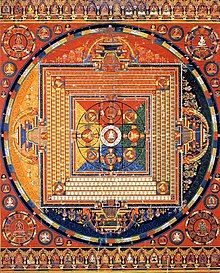


In the tantric Buddhist literature, each of the five Buddhas have extensive qualities and features, including different directions, colors, mudrā, symbol, aspects, klesha, element; consort and spiritual son, as well as different animal vehicles (elephant, lion, peacock, harpies or garuda, or dragon).
The cardinal positions of Akshobhya and Vairocana can alter depending on specific teachings. In a classic schema, Vairocana may be seen as embodying sovereignty as the lord of the mandala and thus is at the central place of the mandala. Akshobhya then may face east as the second Buddha, and embodies steadfastness. He may be seated in the Vajraparyanka (also known as Bhūmisparśa) pose, with the right hand on the right knee, palm turned inwardly, and middle finger touching the ground. Amitābha (Japanese: Amida), embodies measureless light and faces west. A statue of Amitābha, when seated, has a samadhi mudrā with both palms face up, on top of each other, in his lap.
When these Five Buddhas are represented in mandalas of distinct Buddhist traditions, they may not always have the same colour or be related to the same direction. As mentioned, Akshobhya and Vairocana may be switched, as in the Guhyasamaja system which has Aksobhya in the center, and as in the Longchen Nyingtig tradition where Akshobhya is also in the center.
In other cases, different Buddhas may take the center place as well depending on the teaching cycle or tantra which is being depicted.
When represented in a Vairocana mandala of the Vajradhatu, the Buddhas are arranged as follows:
| Amoghasiddhi (North) | ||
| Amitābha (West) | Vairocana (Center) | Akshobhya (East) |
| Ratnasambhava (South) |
Main aspects of the Five Families
There is an expansive number of associations with each element of the Five Buddhas mandala, so that the mandala becomes a cipher and mnemonic visual thinking instrument and concept map; a vehicle for understanding and decoding the whole of the Dharma.
In numerous Vajrayana sources, each Buddha Family or Division has numerous symbols, secondary figures including bodhisattvas, protectors, etc., abilities, and aspects.
Some of the main esoteric associations of each family include:
| Family (Skt, Kula) | Buddha | Colour and Element | Aggretate | Klesha | Mudra | Throne | Bījasyllable | Wisdom (jñana) |
|---|---|---|---|---|---|---|---|---|
| Buddha Family | Vairocana | White, Earth | Form (or Consciousness) | Aversion (or Ignorance, ávidyā) | Teaching Mudra | Lion throne | Om | Perfectly Pure Dharma sphere Jñana |
| Vajra Family | Akṣobhya | Blue, Space |
Consciousness (or Form) (rupa) |
Ignorance (or Aversion) | Earth-touching Mudra | Elephant throne | Hum | Mirror-like Jñana |
| Ratna (Jewel) Family | Ratnasambhava | Yellow, Water | Feeling (vedana) | Pride (or Greed) | Giving Mudra | Horse throne | Tram | Sameness Jñana |
| Padma (Lotus) Family | Amitābha | Red, Fire | Perception (saṃjñā) | Craving | Meditation Mudra | Peacock throne | Hrih | Discriminating Jñana |
| Karma Family | Amoghasiddhi | Green, Wind | Volition (samkhara) | Envy | Fearlessness Mudra | Garuda throne | Ah | Perfect practice Jñana |
Five female Buddhas and the families
Each male Buddha is paired with a female Buddha, often called mothers, prajña, vidya, or consort. Together, each family also presides over their own pure land or buddhafield. Although all five families abide in pure lands, it appears that only Sukhavati of Amitābha, and to a much lesser extent Abhirati of Akshobhya, where great masters like Vimalakirti and Milarepa are said to dwell, were popularly venerated. Some temples include all five Buddhas in their mandalas and statuary.
The Five Tathāgathas are protected by five Wisdom Kings called Vidyārājas, and in China and Japan they are frequently depicted together in the Mandala of the Two Realms. In the Shurangama Mantra revealed in the Śūraṅgama Sūtra, an especially influential dharani in the Chinese Chan tradition, the Five Tathāgathas are mentioned as the hosts of the five divisions which control the vast armies of the five directions.
In an early Indian Yoga Tantra of the Five Families, the five prajña consorts or five mothers (Tib. ཡུམ་ལྔ་, Wyl. yum lnga), the associated bodhisattvas and their pure lands that correspond to the Five Tathagatas are:
| Buddha (Skt) | Wisdom Consort (prajña) | Bodhisattva | Vidyārāja protector | Pure land and direction |
|---|---|---|---|---|
| Vairocana | Ākāśadhātvīśvarī, also known as Vajradhātvisharī, Buddhaḍākinī or Sparśavajrī | Vajraparamita or Vajrasattva | Acala | Akaniṣṭha-Ghanavyūha (Center) |
| Akṣobhya | Locanā, also known as Buddhalocanā, Tathāgatalocanā | Vajrapani or Samantabhadra | Trailokyavijaya | Abhirati (East) |
| Amitābha | Paṇḍāravāsinī, also known as Sitavāsinī | Avalokiteśvara | Yamāntaka | Sukhāvatī (West) |
| Ratnasaṃbhava | Māmakī | Mañjusri, Ratnapani | Kuṇḍali | Śrīmat (South) |
| Amoghasiddhi | Tara, Samayatārā | Maitreya, or Viśvapāni | Vajrayakṣa | Karmaprasiddhi or Prakuṭā [es] (North) |
Other tantras and commentaries provide alternative families and listings of the male and female Buddha pairings. In some systems, like the Guhyasamāja Tantra, Akṣobhya appears at the center of the mandala, with Sparśavajrī as consort. Sometimes Tara may appear as associated with the Lotus family, since one tradition states that she was born of Avalokitesvara.
Each female Buddha also has their own mantra, for example Pāṇḍaravāsinī's mantra in the Mañjuśrīmūlakalpa (ch 37) is:
Oṁ kaṭe vikaṭe nikaṭe kaṭaṅkaṭe kaṭavikaṭakaṭaṅkaṭe svāhā
Buddhalocanā's mantra in the Mañjuśrīmūlakalpa (found in chapter 37) is:
oṁ ru ru sphuru jvala tiṣṭha siddhalocane sarvārthasādhani svāhā
According to the Guhyasamājatantra, each Buddha family is also assigned a specific mantra:
- Vairocana - Buddha family mantra: jinajik
- Akṣobhya - Vajra family mantra: vajradhr̥k
- Ratnasambhava - Ratna family mantra: ratnadhr̥k
- Amitābha - Lotus family mantrs: ārolik
- Amoghasiddhi - Karma family mantra: prajñādhr̥k
The "Sixth" Buddha, the dharma-body
The Five Buddhas may also be seen as aspects of the Dharmakāya or "dharma-body", which reflect all apparent phenomena. The Vajrasekhara Sutra also mentions a sixth Buddha, Vajradhara, "a Buddha (or principle) seen as the source, in some sense, of the five Buddhas." This idea later developed into a tantric idea of the Adi-Buddha, which generally came to be seen as the ground of all the Five Buddhas, as the Dharmakāya itself, the ultimate reality which spontaneously manifests the Five Buddha families. Different Buddhist traditions understand and name their highest Buddha in various ways. In the Nyingma school, the highest Buddhas are known as Samantabhadra and Samantrabadri. In Shingon Buddhism, it is Mahavairocana. In Japanese Pure Land Buddhism, they understand all Buddhas as manifestations of Amitābha.
Gallery
-
 Ancient painting of Pancha Maha Thathagatas, Amoghasiddhi (green), Akshobhya (blue), Amitabha (red), Vairocana (white), Ratnasambhava (yellow) (date 1100–1200) in Nepal.
Ancient painting of Pancha Maha Thathagatas, Amoghasiddhi (green), Akshobhya (blue), Amitabha (red), Vairocana (white), Ratnasambhava (yellow) (date 1100–1200) in Nepal.
-
 Jin Dynasty (1115–1234) statue of Amoghasiddhi in Shanhua Temple in Datong, Shanxi, China
Jin Dynasty (1115–1234) statue of Amoghasiddhi in Shanhua Temple in Datong, Shanxi, China
-
 Jin Dynasty (1115–1234) statue of Amitabha in Shanhua Temple in Datong, Shanxi, China
Jin Dynasty (1115–1234) statue of Amitabha in Shanhua Temple in Datong, Shanxi, China
-
 Jin Dynasty (1115–1234) statue of Vairocana in Shanhua Temple in Datong, Shanxi, China
Jin Dynasty (1115–1234) statue of Vairocana in Shanhua Temple in Datong, Shanxi, China
-
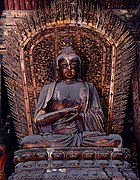 Jin Dynasty (1115–1234) statue of Ratnasambhava in Shanhua Temple in Datong, Shanxi, China
Jin Dynasty (1115–1234) statue of Ratnasambhava in Shanhua Temple in Datong, Shanxi, China
-
 Jin Dynasty (1115–1234) statue of Akshobhya in Shanhua Temple in Datong, Shanxi, China
Jin Dynasty (1115–1234) statue of Akshobhya in Shanhua Temple in Datong, Shanxi, China
-
 Ming dynasty (1368-1644) statue of Amoghasiddhi in Huayan Temple in Datong, Shanxi, China
Ming dynasty (1368-1644) statue of Amoghasiddhi in Huayan Temple in Datong, Shanxi, China
-
 Ming dynasty (1368-1644) statue of Amitabha in Huayan Temple in Datong, Shanxi, China
Ming dynasty (1368-1644) statue of Amitabha in Huayan Temple in Datong, Shanxi, China
-
 Ming dynasty (1368-1644) statue of Vairocana in Huayan Temple in Datong, Shanxi, China
Ming dynasty (1368-1644) statue of Vairocana in Huayan Temple in Datong, Shanxi, China
-
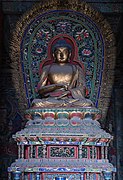 Ming dynasty (1368-1644) statue of Ratnasambhava in Huayan Temple in Datong, Shanxi, China
Ming dynasty (1368-1644) statue of Ratnasambhava in Huayan Temple in Datong, Shanxi, China
-
 Ming dynasty (1368-1644) statue of Akshobhya in Huayan Temple in Datong, Shanxi, China
Ming dynasty (1368-1644) statue of Akshobhya in Huayan Temple in Datong, Shanxi, China
-
 Five Thathagatas painting (Date 1400-1500), Ratnasambhava, Akshobhya, Vairocana, Amitabha, Amoghasiddhi / Himalayan art resources foundation in Nepal
Five Thathagatas painting (Date 1400-1500), Ratnasambhava, Akshobhya, Vairocana, Amitabha, Amoghasiddhi / Himalayan art resources foundation in Nepal
-
 Shrine to the Five Tathagathas in Kaiyuan Temple in Quanzhou, Fujian, China
Shrine to the Five Tathagathas in Kaiyuan Temple in Quanzhou, Fujian, China
-
 Shrine to the Five Tathagathas in Bixia Temple on Mount Wutai in Shanxi, China
Shrine to the Five Tathagathas in Bixia Temple on Mount Wutai in Shanxi, China
-
 Chinese shrine to the Five Tathagathas in Nan Tien Temple in Wollongong, Australia
Chinese shrine to the Five Tathagathas in Nan Tien Temple in Wollongong, Australia
-
 Five Tathagatas in Shinshoin Temple (Shibamata, Katsushika, Tokyo) . From the right side, Akshobhya, Ratnasambhava, Vairocana, Amitābha, and Amoghasiddhi
Five Tathagatas in Shinshoin Temple (Shibamata, Katsushika, Tokyo) . From the right side, Akshobhya, Ratnasambhava, Vairocana, Amitābha, and Amoghasiddhi
-
 Painting of the Five Buddhas, circa the 6th year under Injo of Joseon Dynasty (1628), Korea
Painting of the Five Buddhas, circa the 6th year under Injo of Joseon Dynasty (1628), Korea
-
 Gilt copper crown with five buddhas, Tibet, 1644-1911 CE.
Gilt copper crown with five buddhas, Tibet, 1644-1911 CE.
-
 Ritual Diadem with the Five Jina Buddhas, Northern Nepal or Tibet, 19th century
Ritual Diadem with the Five Jina Buddhas, Northern Nepal or Tibet, 19th century
-
 Five Buddhas, Nepal, 16th century
Five Buddhas, Nepal, 16th century
-
 Statues of the Five Tathagathas, Tri Ratna Buddhist Centre, Pekanbaru, Sumatra
Statues of the Five Tathagathas, Tri Ratna Buddhist Centre, Pekanbaru, Sumatra
-
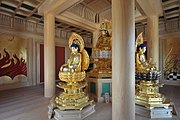 Renge-in Tanjō-ji
Renge-in Tanjō-ji
See also
- Dharma
- Dharmadhatu
- Diamond Realm
- Four Paramatthas
- Garbhagriha
- List of the named Buddhas
- Trikaya
- Womb Realm
References
- ^ Buddha Weekly, Five Female Buddhas or Mothers: Their Roles as Prajnas or Enlightened Wisdom — Inseparable Co-Equals Rather Than Consorts, https://buddhaweekly.com/five-female-buddhas-or-mothers-their-roles-as-prajnas-or-enlightened-wisdom-inseparable-co-equals-rather-than-consorts/, "What is often misunderstood is the concept that even if you practice a single Buddha, for example, Amitabha, he is never separate from his Female Co-Equal Buddha Pandara. Or, if you practice Green Tara as a sole practice, she is never separate from her co-Equal Male Budddha Amoghasiddhi."
- ^ Terton Jigme Lingpa, "Yumka Dechen Gyalmo" (འུྃཿ ཀློང་ཆེན་སྙིང་གི་ཐིག་ལེ་ལསཿ), from the Longchen Nyingtig, 18th c.
- ^ Williams, Wynne, Tribe (2000). Buddhist Thought: A Complete Introduction to the Indian Tradition, p 210. Routledge.
- "香光莊嚴". www.gaya.org.tw. Retrieved 2021-05-12.
- Hong, Tsai-Hsia (2007). The Water-Land Dharma Function Platform Ritual and the Great Compassion Repentance Ritual (Thesis). OCLC 64281400. ProQuest 304764751.
- Bogle (1999) pp. xxxiv-xxxv
- Saunders, E Dale, "A Note on Śakti and Dhyānibuddha," History of Religions 1 (1962): pp. 300-06.
- ^ Tanaka, Kimiaki (2019-05-07). The origin of Japanese two world mandala | SOAS University of London. Retrieved 2024-09-25 – via YouTube.
- Tanaka, Kimiaki. An Illustrated History of the Mandala: From Its Genesis to the Kalacakratantra, chapter 6 (6.2), Simon and Schuster (2018).
- Tanaka, Kimiaki. An Illustrated History of the Mandala: From Its Genesis to the Kalacakratantra, chapter 6 (6.9), Simon and Schuster (2018).
- ^ Sakya, p. 35, 76.
- "The Lotus Sutra focus on Śākyamuni also fits the main Buddha figure in Zen, rather than the Buddhas Amida or Vairocana venerated in the contemporary Pure Land and Esoteric (and Kegon) movements." in Taigen Dan Leighton (2007). "Dōgen's Interpretations of This Lotus Sutra Story". Dōgen's Appropriation of Lotus Sutra Ground and Space. Oxford Academic. pp. 67–94. doi:10.1093/acprof:oso/9780195320930.003.0004. ISBN 978-0-19-532093-0.
- "One of the two wives of Songtsen Gampo, she brought a large image of either Shakyamuni or Akshobhya Buddha (they are visually indistinguishable)..." in "Glossary (Balza, Balmoza)" (PDF). The Huntington Archive, Ohio State University. Archived from the original (PDF) on April 9, 2011. Retrieved January 22, 2012.
- Sakya, p. 30.
- Similarities with Amitabha in "Who's Who of Buddhism". Vipassana Foundation. Archived from the original on January 11, 2009. Retrieved January 14, 2011.
- ^ John C. Huntington, Dina Bangdel. The Circle of Bliss: Buddhist Meditational Art, p. 226, 444. Serindia Publications, Inc., 2003
- ^ Nicolas Revire, Rajat Sanyal, Rolf Giebel. Avalokiteśvara of the "Three and a Half Syllables": A Note on the Heart-Mantra Ārolik in India. Arts Asiatiques, 2021, Arts Asiatiques, 76, pp.5-30. ⟨10.3406/arasi.2021.2095⟩. ⟨halshs-04142356⟩
- ^ Williams et al. Buddhist Thought: A Complete Introduction to the Indian Tradition, p. 211. Routledge, Jan 4, 2002
- The Śūraṅgama sūtra: a new translation. Ukiah, Calif: Buddhist Text Translation Society. 2009. ISBN 978-0-88139-962-2. OCLC 300721049.
- Kimiaki Tanaka. An Illustrated History of the Mandala From Its Genesis to the Kalacakratantra, Simon and Schuster (2018)
- Journey Without Goal: The Tantric Wisdom of the Buddha, The Collected Works of Chögyam Trungpa, Volume Four (Boston & London: Shambhala, 2003), Ch. 9 'The Five Buddha Families'.
- "五大尊". Flying Deity Tobifudō (Ryukō-zan Shōbō-in Official Website). Retrieved 2021-10-01.
- Longchenpa (2014). "XIII". The Great Chariot. p. Part 3e.2a.
- ^ "The Root Manual of the Rites of Mañjuśrī / 84000 Reading Room". 84000 Translating The Words of The Buddha. Retrieved 2024-09-24.
- Getty, Alice (1914). The gods of northern Buddhism: their history, iconography and progressive evolution through the northern Buddhist countries. Oxford Clarendon Press via Internet Archive. p. 3.
Bibliography
- Bogle, George; Markham, Clements Robert; and Manning, Thomas (1999) Narratives of the Mission of George Bogle to Tibet and of the Journey of Thomas Manning to Lhasa ISBN 81-206-1366-X
- Bucknell, Roderick & Stuart-Fox, Martin (1986). The Twilight Language: Explorations in Buddhist Meditation and Symbolism. Curzon Press: London. ISBN 0-312-82540-4
- Sakya, Jnan Bahadur (compiler) (2002) . Short Description of Gods, Goddesses and Ritual Objects of Buddhism and Hinduism in Nepal (10th ed.). Handicraft Association of Nepal. ISBN 99933-37-33-1.
External links
- Five Dhyani Buddhas - chart of the Five Buddhas and their associations.
- StudyBuddhism.com - The Five Buddha-Families and Five Dhyani Buddhas
- Five Dhyani Buddhas Mandala - Thangka painting of the Five Buddhas.
- Symbolism of the five Dhyani Buddhas
- Video demonstration the mantra chanting and mudras used during the Chinese Yogacara Flaming Mouth ceremony (瑜伽焰口法會) to invoke the Five Tathagathas in the ritual space.
- Praise to the Five Buddhas (Chinese: 禮讚五方佛; Pinyin: Lǐzàn Wǔfāngfó), part of the liturgy chanted in certain Chinese monastaries.
- Color Symbolism In Buddhist Art
- Mark Schumacher: Godai Nyorai (Japanese) - Five Buddha of Wisdom Five Buddha of Meditation Five Jina | Five Tathagatas
- The Five Buddha Families - From Journey Without Goal: The Tantric Wisdom of the Buddha by Chögyam Trungpa, Shambhala.org (archived 2007)
- 5 Dhyani Buddhas - 5 Dhyani Buddhas detailed with table
